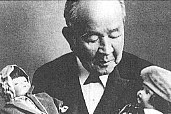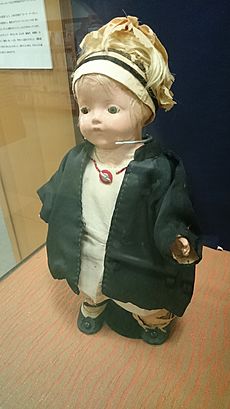Japanese friendship dolls facts for kids

Japanese friendship dolls (友情人形, yūjō ningyō) (also called Japanese ambassador dolls) and the American blue-eyed dolls (青い目の人形, aoi me no ningyō) were special programs that helped create goodwill between Japan and the United States. In the 1920s, an American missionary named Sidney Gulick, who lived in Japan, started an idea to exchange dolls between children. He hoped this would help ease tensions between the two countries. A Japanese leader, Viscount Eiichi Shibusawa, liked this idea and started a program to send 58 dolls from Japan to museums and libraries in America.
A similar type of doll is the Kokeshi doll.
Contents
Why Dolls Were Sent
In 1924, the United States passed a law called the Immigration Act of 1924. This law stopped people from East Asia from moving to the U.S., which caused a lot of tension between America and Japan.
Dr. Sidney Gulick was a missionary who had lived in Japan for many years. He knew how important dolls were in Japanese culture. To help improve feelings between the two countries, he came up with a plan to send dolls from the U.S. to children in Japan.
Gulick helped create a group called the Committee on World Friendship Among Children. In 1927, their first big project was to send 12,739 friendship dolls (also known as American blue-eyed dolls) to Japan. These dolls arrived just in time for Hinamatsuri, which is Japan's yearly doll festival.
Japan's Gift of Friendship Dolls
Inspired by this kind act, Viscount Eiichi Shibusawa led a project in Japan to send a gift back. The best doll makers in Japan were asked to create 58 special friendship dolls.
Each of these dolls was about 32 to 33 inches tall. They wore beautiful kimonos made of silk and came with unique accessories. Each Japanese friendship doll represented a specific Japanese prefecture (like a state), city, or region. These dolls were then sent to libraries and museums all across the United States.
Later on, Denny Gulick, who is Sidney Gulick's grandson, has tried to bring back the idea of this doll exchange.
American Blue-Eyed Dolls: A Closer Look
In 1927, American children sent more than 12,000 Friendship Dolls to elementary school children in Japan. This was a wonderful way to show friendship. Churches and schools across the U.S. donated these dolls. It was suggested that each doll should have a "Mama voice" and cost no more than $3.00.
Each doll was sent with a special message. This message included the doll's name, the names of the children who gave it, and an address for a "thank you" letter. The dolls even had farewell parties! They were given "passports" that cost 1 cent and "railroad and steamer tickets" that cost 99 cents.
It was suggested that "girls focus on choosing the dolls and making their clothes, and that boys act as business and ticket agents." The dolls also came with a poem called "Friends Across the Sea," written by Robert Underwood Johnson for the Committee of World Friendship among Children.
A small number of these dolls (fewer than 100) were sent to Formosa (now Taiwan) and given to different elementary schools and kindergartens there. Only 334 of these dolls survived World War II and are now carefully preserved in Japan.
- Dolls of friendship; the story of a goodwill project between the children of America and Japan, by Committee on World Friendship Among Children. New York, Friendship Press 1929
Images for kids
-
Miss Shimane at the Children's Museum of Indianapolis



